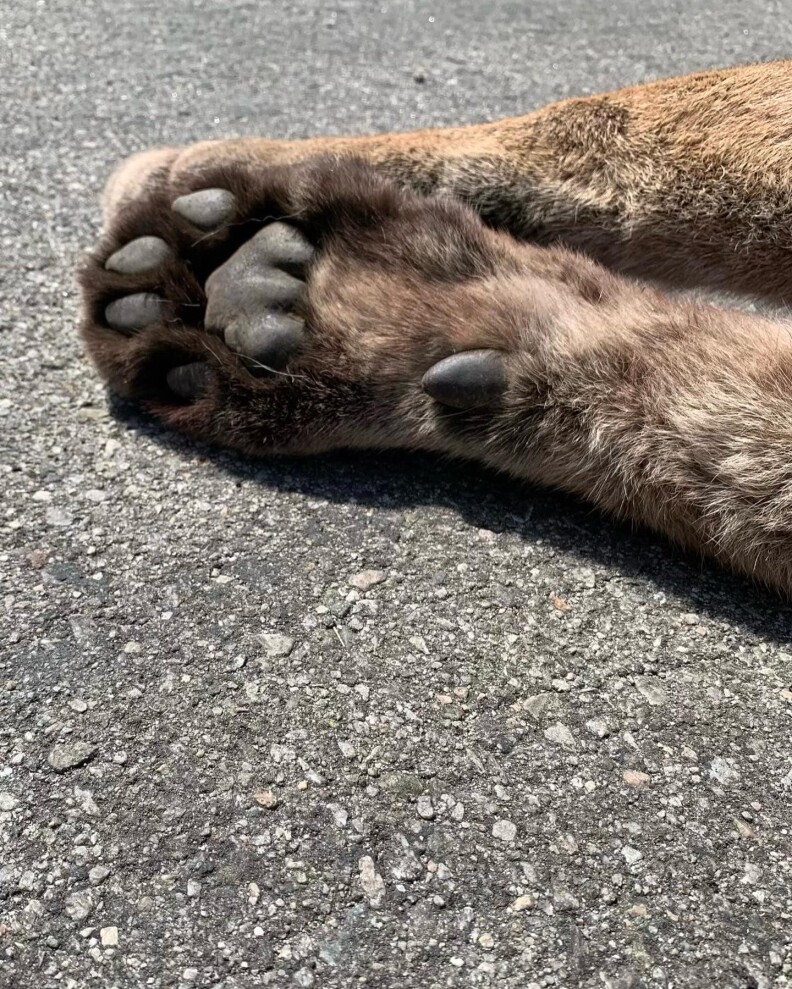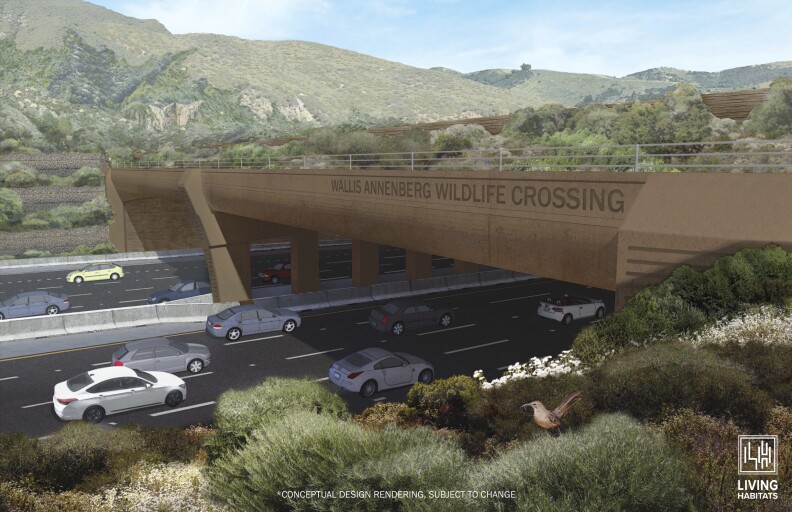Here's How LA Is Going To Construct The World's Largest Wildlife Crossing

Intentionally dropping tons upon tons of earth on top of one of the busiest freeways in the United States may seem unwise.
But it will be necessary in order to complete the world’s largest wildlife crossing. The Liberty Canyon Wildlife Crossing will stretch 210 feet across eight lanes of the 101 freeway.
On Friday, Earth Day, the $90 million project broke ground in Agoura Hills. It's a ceremonial first step, but the most tangible one for the ambitious crossing that has existed strictly in the abstract for years.
Those years have felt like eons for Beth Pratt, California Regional Executive Director for the National Wildlife Federation. She’s one of the crossing’s biggest champions and shoulders the load with gusto. The groundbreaking was a win for her — and for P-22, L.A.’s famous wandering mountain lion of Griffith Park.
“I just kept thinking of P-22,” Pratt said. “I honored a promise to him … I fulfilled my promise. We did it … we gave this mountain lion population a shot.”

-
Ippei Mizuhara to plead guilty to bank fraud
-
New effort to get drivers to slow down on PCH
-
Why these sibling planets are no longer near twins
The so-called “Brad Pitt” of mountain lions has called L.A. home for a decade now, but his trek wasn’t an easy one. He left his original habitat of the Santa Monica Mountains and crossed two freeways to finally rest his paws and become an Angeleno. This Odyssean journey, however, was an unnatural one, according to Pratt.
"Basically it comes down to this — I've stood at the 101 at 2 a.m. and I still wouldn't cross, and that's what these animals are pretty much saying — they come to the 101, they look at it and they're like ... no way am I trying that."
And the data shows that, for the most part, animals do not try that. More than 100,000 GPS tracking points from the National Park Service show mountain lions approaching that particular spot on the freeway, then turning right back around without attempting the hazardous cross.

But not every big cat is deterred by the fast-moving traffic. The day before the groundbreaking, P-97, an 18-month mountain lion, died after being struck by a driver on the 405 in Brentwood. He was the 26th GPS-collared member of his species to be struck and killed by a vehicle in the past two decades, according to the National Park Service.
Barrier To Movement
The 101 is particularly culpable in the deaths of mountain lions — between 2002 and 2017, seven were killed on the 101 freeway. The mountain lions can co-exist in and around the second-largest city in the U.S., but their freedom to roam will always be impeded by one of its busiest thoroughfares, according to a 2014 study published in Current Biology.
“The Santa Monica Mountains (SMMs), a large natural area within Greater Los Angeles, is completely isolated by urban development and the 101 freeway to the north,” reads the study.

“Yet the SMMs support a population of mountain lions (Puma concolor), a very rare example of a large carnivore persisting within the boundaries of a megacity. GPS locations of radio-collared lions indicate that freeways are a near-absolute barrier to movement.”
According to the National Park Service, just nine of the big cats have ever successfully crossed the 101.
Restitching An Ecosystem
Humans are the leading cause of death for mountain lions, whether on the roads, through the use of rodenticide, or through climate change-induced wildfires, according to a 2015 study from UC Davis.
But humans, too, can also fix the damage they’ve caused by building wildlife crossings, which re-graft together the natural habitats severed by major freeways decades ago and grant safe passage once again.

Architect Robert Rock is the C.O.O and Principal of Living Habitats, the company leading the design of the Liberty Canyon project. Although the span’s size grabs the most headlines, the makeup of the project — part bridge construction and part ecological restoration — is what makes it especially unique.
“I don't really know of a project that has kind of taken on the challenge of completely reconnecting an entire ecosystem at this scale … We're transforming this in an area that is one of the most urbane locations on the planet,” Rock said.
“And so for us to design this, thinking about everything from the soil biology, all the way up to that apex predator, means that we're re-stitching an ecosystem from north to south. That's something different from just creating a conduit.”

The standard transit project side of things comes first — abutments will be built on both sides of the freeway and what's called a bent, the center support of the span, will be installed on the median. Next, the bridge deck, built from pre-cast elements to cut down on costs and construction time, will be swung across and the gap will be closed.
Shortly thereafter, “the real fun starts,” according to Rock. The task? Turning a hunk of concrete into a living, breathing thing.
The span needs to appear, at least to local wildlife, as it did a century ago, before the 101 bisected Liberty Canyon.
So there needs to be soil. Lots of it. According to Rock, it’s like putting an entire football field across the top of the freeway.
“It's soil, not dirt,” Rock said. “[We have] this comprehensive approach … all the way from the structural engineer down to the mycologist. We are sourcing native fungi from the site and from adjacent areas, that we're going to use to inoculate the soil, to put the fungal content, bacteria and microorganisms back into the soil.”

Every aspect has thought poured into it — such as shielding the animals from light reflected by passing cars (the bridge will be cast with a specific color of concrete to match the habitat). Or protecting them from the ever-present traffic static by hiring an acoustic engineer to help create sound walls and barriers complete with greenery.
The World Is Watching
The project, made possible by both private donations and private funds, will be the first wildlife crossing CalTrans has ever constructed. The undertaking has two phases, in name at least.
The first non-ceremonial shovel will enter the earth this summer, according to Sheik Moinuddin, the Caltrans project manager for the corridor.
“So about the middle of June, they're ready to go. They're given about 500 days to finish the contract. Obviously, they can finish it early, and we're happy.”
Phase one represents the initial reach across the 101, while Phase 2 is the final hop over an adjacent frontage road. Those 500 days for Phase One start ticking come summer, when the contract begins — July 14, according to Moinuddin.
The entire project is expected to be finished by 2025.
For Moinuddin, this infrastructure project is unlike the many he’s managed before — it carries a certain distinctive weight.
“It is a fulfilling thing, at least for me. And obviously, for Caltrans, too. This is the largest of its kind in the world. And we're building it. And everybody's looking at this project,” Moinuddin said.
“If [this] can happen in urban areas, like in L.A., it can be done in any other places in the world, right? I mean, we're, we're carrying 300,000 vehicles a day. And we're building a wildlife crossing.”
The world is watching. And so, too, are the mountain lions, waiting in the wings for their way across those lanes of traffic.
It seemed so distant for so long, but now that it’s arrived, it might just be time for a good sob, according to Pratt.
“I'm gonna cry at groundbreaking," she'd prophesied earlier.
Editor’s note: she did.
-
Sandhill cranes are returning to the Lake Tahoe basin after a century long hiatus in what many say is a conservation success story.
-
Jackie’s partner, Shadow, refuses to abandon their unviable eggs, despite her attempts to nudge him along.
-
We do have some of the same types of buildings here.
-
Switching to an electric heat pump water heater can save you money and help the state avoid power outages.
-
The state's parks department is working with stakeholders, including the military, to rebuild the San Onofre road, but no timeline has been given.
-
Built in 1951, the glass-walled chapel is one of L.A.’s few national historic landmarks. This isn’t the first time it has been damaged by landslides.











